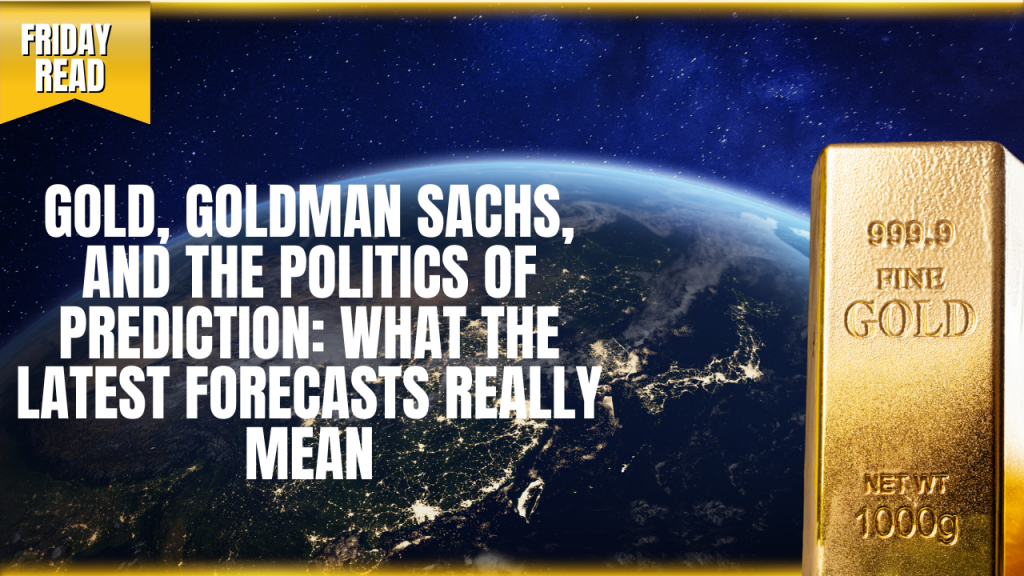
In the spring of 1933, as the world reeled from the Great Depression, Franklin D. Roosevelt stunned Americans by seizing private gold holdings and decoupling the dollar from its golden anchor (something we discussed, earlier this week). The move was as much about psychology as economics: gold, that ancient store of value, had become a barometer of public trust in money itself. Nearly a century later, the metal’s role as a mirror of anxiety and ambition remains undimmed.
So when Goldman Sachs, the high temple of Wall Street orthodoxy, raises its gold price target, the world listens, not for clairvoyance, but for clues about the mood music of global finance. Their latest note, published earlier this week, lifts the year-end target to $3,700 per ounce, with $4,000 in sight by mid-2026. The headlines trumpet bullishness, but the real story is more nuanced: Goldman’s forecasts are less prophecy, and instead more pulse-check, revealing how the world’s most influential bank is reading the shifting tides of market psychology.
The Art of the Revision
What stands out in Goldman’s gold coverage is not a single number, but the choreography of their revisions. In February, the 2025 target crept from $2,890 to $3,100. By March, it was $3,300. Now, the upper bounds flirt with $4,000, or more in stress scenarios. This is not exuberant prediction-making; it is reactive, almost cautious, forecasting. Lina Thomas and her team are not so much leading the market as following it, step by step, as central bank buying outpaces expectations and ETF inflows prove stickier than models suggest.
For a bank once derided for its tardiness in precious metals, this incrementalism has the air of penance. But it also signals something deeper: a recognition that gold’s narrative is being rewritten in real time, not by Wall Street, but by the world’s central banks and institutional allocators.
The Buyers Who Move the Needle
Goldman’s analysis draws a sharp distinction between “conviction buyers”, the central banks and long-term investors and the “opportunistic buyers” such as households in India or China. The former, they estimate, are the true price-setters: every 100 tonnes of central bank purchases adds roughly 1.7 per cent to the price. The latter, while important for smoothing volatility, do not dictate direction.
Download Your Essential Checklist
This framing is both elegant and revealing. The gold market is not about jewellery demand or retail speculation. It is a stage on which sovereigns quietly reshape reserve portfolios, and large funds recalibrate for a world where bonds and equities no longer hedge one another. This is something many of us in this industry have been harping about for a while but it is now an acceptable theory. And, more importantly the likes of Goldmans are seeing gold for what it is: less a shiny bauble than a strategic instrument of statecraft and risk management.
Scenario Analysis or Narrative Hedging?
Goldman’s scenarios add colour, but also expose the limits of forecasting. In a recession, they say, ETF inflows could surge back to pandemic levels, propelling gold to $3,880. In a strong growth environment, gold may plateau near $3,550. Ultra-bull cases suggest $4,000+, driven by relentless central bank demand.
On paper, this is prudent scenario analysis. In practice, it is a narrative hedge: the range is so broad that almost any outcome can be rationalised after the fact. If gold ends 2025 at $3,550, Goldman will point to their “growth case”; if it is $3,900, they will highlight their “recession case.” The band is not a guide, it is a mirror, reflecting the uncertainty of the age.
Nothing Makes Sense Anymore (Here’s Why)
The Portfolio Problem
Perhaps the most compelling insight in Goldman’s notes of late are not about gold itself, but about the collapse of old portfolio relationships. Macro strategist Vickie Chang observes that the classic hedges (equities against bonds, bonds against the dollar) are breaking down. The so-called “Sell America” trade has investors rethinking diversification altogether. In this context, gold’s appeal is less about its price trajectory and more about its independence from a financial system increasingly prone to correlation risk.
Here, the gold forecast becomes a commentary on a fractured monetary order, one in which trust is migrating away from paper promises and toward tangible anchors.
Reading Between the Lines
So how should we read Goldman’s bullishness? First, as a reflection of institutional anxiety. A bank like Goldman does not upgrade gold forecasts three times in six months because it has suddenly fallen in love with shiny objects. It does so because its clients are repositioning in ways that force analysts to keep pace.
Second, as a measure of credibility regained. For years, Goldman’s commodity desks were criticised for superficial coverage of gold. The current note, detailed and transparent, is an attempt to repair that reputation.
Third, as a reminder of limits. No forecast can capture the complexity of central bank politics, the fragility of ETF sentiment, or the sudden shocks of geopolitics. Price targets may be useful headlines, but they remain hostage to events.
Conclusion: Gold as the Barometer of Trust
Goldman Sachs has issued a bullish gold forecast, but the real story lies in what this says about the state of markets. Forecasts are not buy signals; they are reflections of mood. They tell us that central banks are still buying, that institutional investors are nervous, and that traditional hedges are failing.
The price of gold may or may not finish 2025 at $3,700. But what Goldman’s note makes clear is that gold has been reborn on the main stage as the asset that reveals our unease with money itself. In a world where trust is in short supply, gold remains the ultimate barometer.
Buy Gold Coins

Buy gold coins and bars and store them in the safest vaults in Switzerland, London or Singapore with GoldCore.
Learn why Switzerland remains a safe-haven jurisdiction for owning precious metals. Access Our Most Popular Guide, the Essential Guide to Storing Gold in Switzerland here.
Receive Our Award Winning Market Updates In Your Inbox – Sign Up Here






